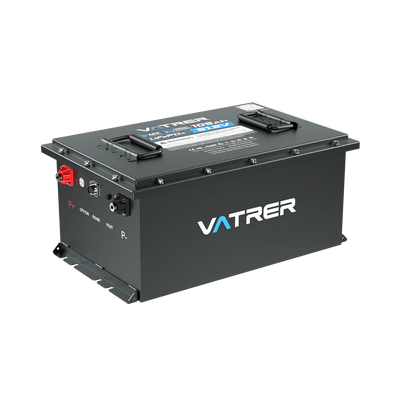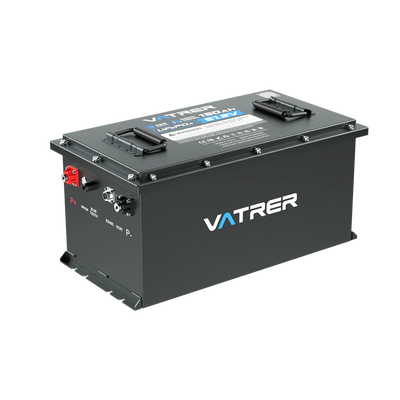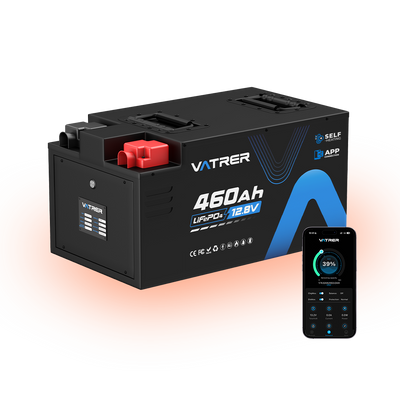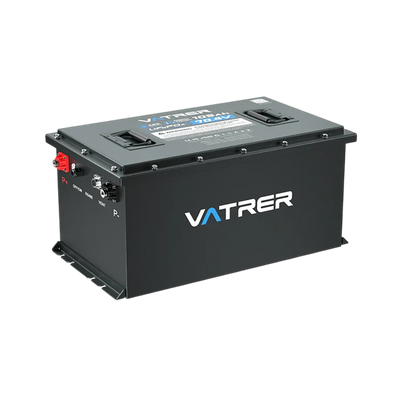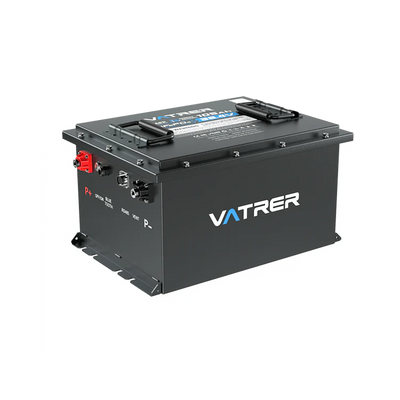RV Battery Winter Storage Comprehensive Guide
Reading time 6 minutes
When temperatures start to drop, many RV owners winterize their vehicles: draining tanks, sealing windows, and covering tires. But one critical step often gets overlooked: RV battery storage.
Cold weather doesn't just slow your vehicle down, it changes your battery's internal chemistry. Poor storage can lead to frozen electrolytes, reduced capacity, or even permanent damage. A neglected RV battery might not survive until spring, leaving you facing expensive replacements and frustrating downtime.
This guide walks you through how to store your batteries properly, protect them from freezing temperatures, and keep your power system healthy, whether you're parking your RV for the season or still hitting the road in colder climates.

How Cold Weather Affects RV Batteries
Cold weather impacts every type of battery differently. When temperatures fall:
- Chemical reactions slow down, leading to weaker voltage and sluggish charging.
- Self-discharge continues even when idle, and cold accelerates voltage loss.
- Flooded lead-acid batteries can freeze if not fully charged, causing internal cracks.
- Lithium RV batteries (LiFePO4) may stop charging below 32°F due to built-in protection in their BMS (Battery Management System).
- Permanent capacity loss can occur if a battery remains deeply discharged over winter.
- Ideal storage temperature: between 40°F and 70°Fin a dry, well-ventilated space.
Tips: If you store your RV outdoors, consider insulating the battery compartment or relocating the battery indoors to protect it from freezing.
Identify Your RV Battery Type Before Storage
Not all RV batteries need the same treatment. Knowing your type ensures you use the right maintenance method and avoid damage.
| Battery Type | Winter Risks | Best Storage Tips |
|---|---|---|
| Flooded Lead-Acid Batteries | Freezing, sulfation, water loss | Keep fully charged, check electrolyte, add distilled water, store in a dry area above freezing |
| AGM (Absorbed Glass Mat) | Gradual capacity loss | Store charged, check voltage monthly, use a trickle charger or smart maintainer |
| Gel Cell | Overcharging risk, temperature sensitivity | Avoid high heat, monitor voltage, store in a temperature-stable space |
| LiFePO4 Lithium RV Battery | Cannot charge below freezing | Store at 40–60% charge, use a heated battery box or self-heating lithium model |
Pro Tips: Modern self-heating lithium RV batteries, like Vatrer's advanced LiFePO4 series, automatically warm up before charging, allowing safe use even at sub-zero temperatures.
Key First Steps RV Battery Before Winterizing
Before you put your RV away for winter, take these essential actions to prevent damage and make spring startup effortless.
a. Fully Charge or Partially Charge the Battery
Charge lead-acid batteries to 100% before storage to prevent sulfation and freezing.
For lithium RV batteries, store at 40-60% charge to reduce long-term stress.
b .Disconnect the Battery
Turn off the RV's main disconnect switch and remove the negative cable first, then the positive.
This stops parasitic draws from clocks, detectors, or control systems that can slowly drain power.
c. Label or Photograph Cables
Take a quick photo before disconnecting so you can reconnect correctly in spring.
d. Remove the Battery (If Possible)
In regions with harsh winters, remove the battery and bring it indoors.
Store it in a dry, temperature-controlled area like a basement or heated garage.
Avoid placing it directly on concrete floors, use a wooden board or insulation pad to prevent moisture contact.
e. Clean the Terminals
Use a wire brush to remove corrosion, then apply a thin layer of dielectric grease to prevent oxidation.
Lead-Acid Battery Storage Tips
Lead-acid batteries need the most attention during winter storage:
- Ensure they are fully charged before storing. A charged battery resists freezing and sulfation better.
- For flooded lead-acid batteries, check electrolyte levels and top up with distilled water to the marked line.
- Store in a cool, dry place above freezing, such as a heated garage.
- Use a smart maintainer or trickle charger every 1-3 months to keep the battery topped off without overcharging.
- Avoid sealed spaces where hydrogen gas could accumulate.
Tips: If you notice white or green buildup on terminals, clean it with a baking soda and water mix before reapplying grease.
Lithium Battery Storage Tips
Lithium RV batteries (especially LiFePO4 chemistry) are much easier to maintain but still require temperature care.
- Store at partial charge (40-60%) rather than full.
- Keep them in a temperature-stable location (ideally 50-68°F). Avoid extended exposure below 32°F.
- Because lithium batteries have a low self-discharge rate, check them every few months and recharge if the voltage drops below ~50%.
- If your battery includes Bluetooth monitoring, use its app to check batteries remotely.
- For active winter camping, use an insulated battery box or heating pad.
Tips: Never try to charge a lithium battery below freezing, it can cause plating on the anode and permanent damage.
Should You Leave the Battery in the RV or Remove It?
Whether to leave your RV battery in the vehicle depends on your storage setup:
| Condition | Recommended Action | Notes |
|---|---|---|
| Very cold climate, no shore power | Remove the battery | Bring it indoors to avoid freezing temperatures |
| Moderate climate, shore power available | Leave in RV | Use a smart charger or maintainer to prevent overcharging |
| Variable conditions | Follow manufacturer’s BMS guidance | Check voltage monthly and keep above 12.4V (lead-acid) or 50% SOC (lithium) |
Tips: Even when stored in the RV, periodically check batteries for voltage, corrosion, and wire integrity.
Monitoring and Maintenance During RV Battery Storage
Proper monitoring during the off-season ensures your RV batteries stay healthy, reliable, and ready for spring. However, maintenance steps differ between flooded lead-acid batteries and lithium RV batteries.
| Battery Type | Charging During Storage | Voltage Check | Temperature Range | Special Care |
|---|---|---|---|---|
| Flooded / AGM Lead-Acid | Use smart maintainer or recharge every 1–3 months | Every 4–6 weeks | Above 40°F | Check water levels, clean terminals |
| Lithium (LiFePO4) | No maintainer; recharge if below 13.0V | Every 2–3 months | 40°F–70°F | Keep 40–60% charge, avoid freezing |
Tips: If your lead-acid battery develops white or green residue, mix baking soda and water to neutralize corrosion before rinsing and drying the terminals. For a lithium RV battery, never attempt to charge the battery below 32°F unless it has a self-heating function, doing so can cause permanent cell damage.
RV Battery Troubleshooting After Winter
Before reinstalling your battery in spring, give it a quick inspection:
- Swollen casing or cracks: discard immediately, this indicates freezing or overcharging.
- Corroded terminals: clean with baking soda and water, rinse, and dry thoroughly.
- Voltage drops quickly after charging: may indicate sulfation or aging cells.
- Unusual smell (rotten eggs): possible acid leak, replace the battery immediately.
- Weak startup: low cold cranking amps, test before relying on it for travel.
Recommended Tools for Winter RV Battery Care
| Tool / Product | Purpose | Example Brands |
|---|---|---|
| Smart Battery Maintainer | Keeps voltage balanced without overcharging | NOCO Genius, Victron Blue Smart |
| Battery Monitor | Tracks voltage, SOC, and temperature | Victron BMV |
| Insulated Battery Box | Prevents freezing and moisture | Camco |
| Heating Pad or Blanket | Maintains lithium operating temperature | Kat’s, Facon |
| Dielectric Grease | Protects terminals from corrosion | CRC, Permatex |
Why Proper Storage Saves Money and Extends RV Battery Life
A battery that's properly stored can last twice as long as one left unattended. Avoiding freeze damage, corrosion, and deep discharges can save you hundreds in replacements.
By maintaining a consistent charge and stable temperature, you protect not just your power supply but also your long-term investment in your RV's electrical system.
Conclusion
Caring for your RV battery through the winter is one of the smartest maintenance choices you can make. Whether you're managing traditional flooded lead-acid batteries or upgrading to lithium RV battery systems, the key is simple: keep them charged, clean, and protected from freezing temperatures.
Vatrer Battery offers advanced lithium RV batteries designed specifically for long-term reliability, with smart BMS protection, low-temperature charging safeguards, and optional self-heating technology. These features make winter storage simple and safe, so your battery is ready when it's time to hit the road again.
Share













































































